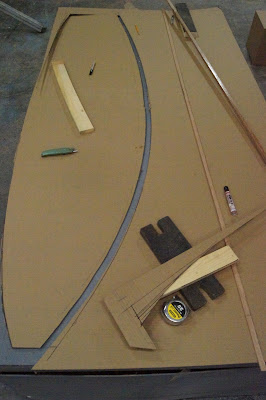Boat design, even for the smallest craft, is actually quite complicated. One of the problems deals with a drafting term called "true view." A boat hull is generally made from plywood which is bent or curved. This creates a twofold challenge: first, how to draw a curvalinear three dimensional object on flat paper. The second problem is how to determine what all of those curved components look like when they laid out on flat plywood in the shop.
Granted, there is computer software that does all this, but it is not cheap. On the other hand, one can make a scale model, but sometimes it is difficult to work these components up to full scale. A quarter inch can mean a lot when putting together plywood, but numbers that small are not always seen in the scale model.
The cardboard model is, of course, exactly the same size as the intended boat: no need for special software, no need to scale up from small to large. Along the way, I learned a lot about drafting out a boat (called lofting in the nautical business), bending and unbending, and fitting everything together as well. It only took a few hours to do. Along the way, I made a lot of small changes that will greatly improve the performance of this boat.
 |
| I begin by drafting the two bilge panels and cutting them out. The curves are drawn with a spline made from half inch mahogany |
 |
| I tape them together along the center line which has been cut along a gentle curve. |

